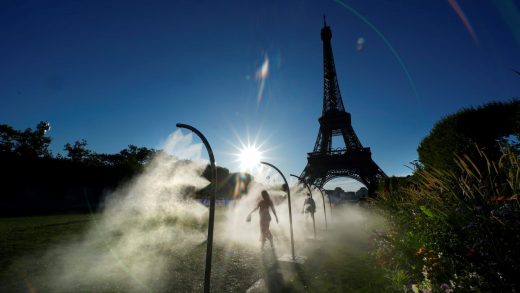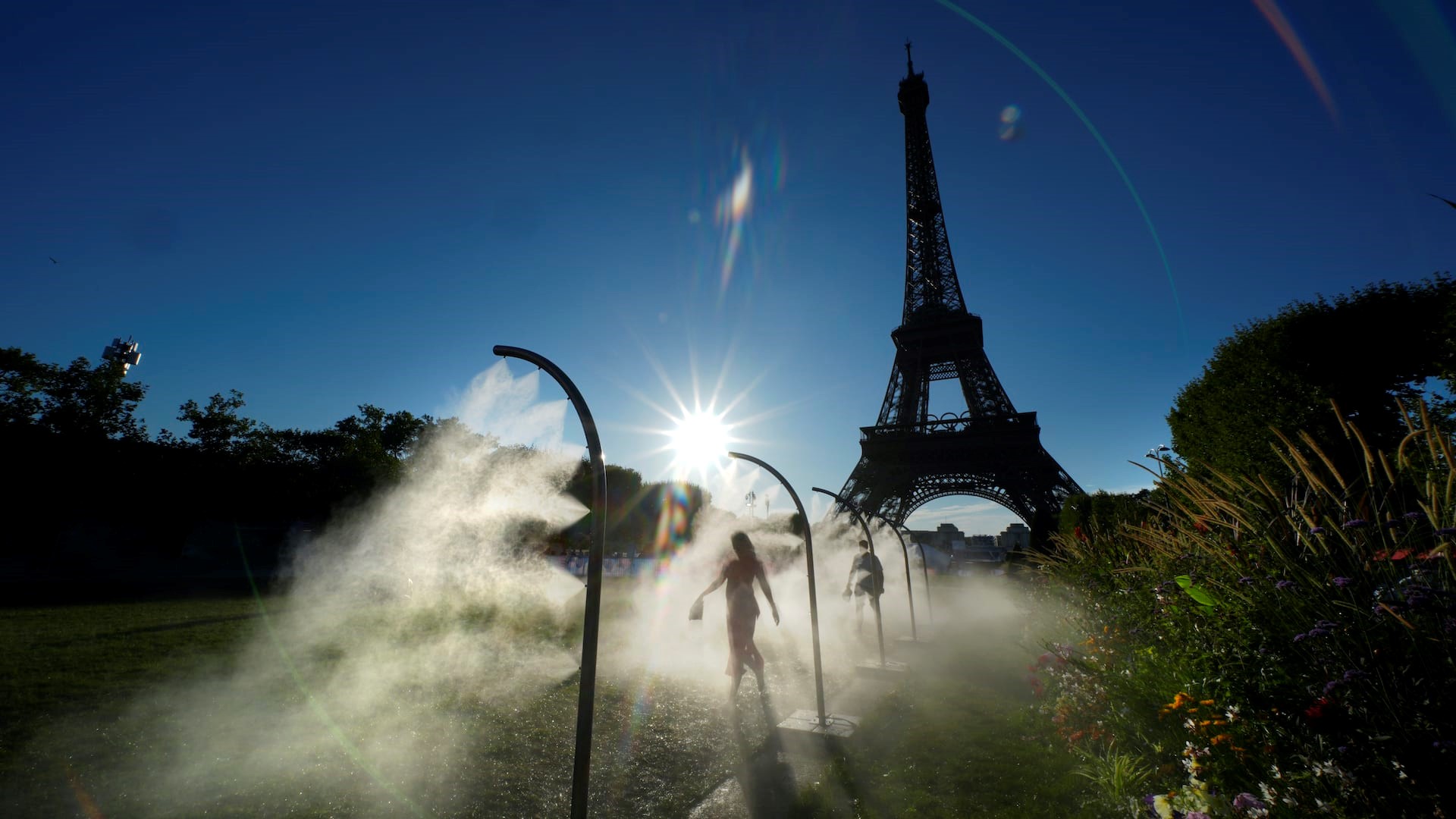‘We are drinking hot water’: How organizers and athletes at the Paris Olympics are handling a heat wave
‘We are drinking hot water’: How organizers and athletes at the Paris Olympics are handling a heat wave
Volunteers used hoses to spray down cheering fans at the shadeless beach volleyball stadium near the Eiffel Tower and put up signs about water refilling areas.
The 2024 Olympics famously launched with a rain-soaked opening ceremony that drenched athletes and spectators alike. They’re enduring the opposite experience Tuesday: a heat wave.
Most of France is under heat warnings, with temperatures in Paris hitting 36 degrees Celsius (97 degrees Fahrenheit), the national weather agency said. Air-conditioning is far less common in French homes, shops, and restaurants than in places in the United States.
The heat was even worse in the south, including the region around the Mediterranean cities of Marseille and Nice that are hosting Olympic competitions like soccer and sailing. It was as hot as 41 C (105 F) in parts of southern France.
Gymnastics superstar Simone Biles posted a video on Instagram struggling with the lack of air-conditioning.
“Don’t come for me about my hair,” Biles wrote on Instagram before the gymnastics team final. “IT WAS DONE but bus has NO AC and it’s like 9,000 degrees. Oh & a 45 minutes ride.”
Back-to-back record global heat was seen last week as climate change makes extreme weather more frequent and intense. Paris 2024 organizers have aimed to cut the event’s carbon footprint, with measures like turning to an underfloor cooling system and insulation instead of air-conditioning at the Olympic village where athletes are staying. Some countries, like the U.S., brought their own air-conditioning units.
Visitors and athletes endured a sweaty and sunny Tuesday before thunderstorms were expected to sweep into the Paris area in the evening. People dipped into a Paris canal that’s a popular swim spot or fanned themselves at exposed Olympic venues.
U.K. tourist Sarah David summed it up with her game plan: “Eating lots of ice cream, lots of water, bought a new fan.”
Volunteers used hoses to spray down cheering fans at the shadeless beach volleyball stadium near the Eiffel Tower and put up signs about water refilling areas. Spectators ducked under trees for shade, while players on the sunbaked sand—which can be more than 20 C (30 F) hotter than the air temperature—took extra breaks to drape bags of ice over their heads and shoulders.
“Very hot,” Egyptian beach volleyball player Doaa Elghobashy remarked after competing in long sleeves, pants, and a hijab. “But not like Egypt.”
People took refuge in misting fountains set up in parts of Paris and venues like La Concorde urban park, which hosts skateboarding and BMX freestyle cycling. The Paris area’s train and metro operator said it was distributing more than 2.5 million containers of water at over 70 train stations and other stops on its network, as well as at bus stations.
The New Zealand women’s rugby sevens team was turning to slushies, ice blocks, shade, ice water, and cold baths before competing.
“We’ve got everything we possibly can to make sure we were cool down before the game, and when you play sevens, it’s hard,” captain Sarah Hirini said.
The equestrian teams sprayed their horses with cool water and kept them in the shade after riding the course, which doesn’t take long. Riders also said they cut down the warmups from 45 minutes to half an hour ahead of competitions held in the regal gardens of the Palace of Versailles outside Paris.
“It’s really hot, but you have to be professional about it,” British rider Carl Hester said after an event Tuesday. “Lots of walk breaks so the horses can relax. We’ve got a covered arena, so it keeps the sun off their backs.”
At Roland Garros, where tennis players competed on outdoor courts, organizers activated the first step of an “extreme weather” protocol, giving athletes in singles matches the chance to request a 10-minute break before third sets. The next step is to suspend play.
British tennis player Jack Draper complained that he wasn’t supplied with enough cold water on court.
“I’m a big, big sweater,” Draper said, his face still covered in perspiration about a half-hour after his three-set loss to Taylor Fritz of the U.S. “The bottles don’t stay cool. We were drinking hot water out there.”
Canada’s Leylah Fernandez, the 2021 U.S. Open runner-up, also complained of “crazy heat” after getting eliminated by Germany’s Angelique Kerber.
“I trained in Spain and also in Miami, where it is hot—this type of weather,” she said. “But sometimes when you’re in a match, it’s a totally different environment. And in the heat, you get to feel all your emotions. . . . I didn’t manage it well.”
French Prime Minister Gabriel Attal urged people to limit their outdoor activities during the day, hydrate, find shade, and protect the most vulnerable—the elderly and young children. He said Olympic organizers were following the “severe heat wave” closely.
France’s national weather agency described heat waves as “increasingly intense, frequent, early, and long-lasting” amid climate change. It said that before 1989, such high temperatures were observed on average once every five years; and since 2000, they repeat every year. It predicts the trend will keep increasing.
—Jimmy Golen, Andrew Dampf, and Courtney Bonnell, Associated Press
John Pye, Stephen Whyno, Sam Petrequin, Jenna Fryer, Howard Fendrich, Hanna Arhirova, Srdjan Nedeljkovic, Andrea Rosa, Jerome Pugmire, Barbara Surk and Giovanna Dell’Orto contributed to this report.
(4)



